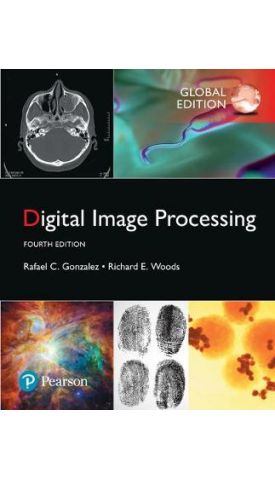אנו משתמשים ב-Cookies כדי לשפר את החוויה שלך. כדי לקיים ההנחיה החדשה של e-Privacy, עלינו לבקש את הסכמתך להגדיר את ה-Cookies. קבלת מידע נוסף.
מחיר מבצע
250.00 ₪
מחיר רגיל
533.00 ₪
Digital Image Processing, Global Edition 4
מחיר מבצע
250.00 ₪
מחיר רגיל
533.00 ₪
ISBN13
9781292223049
יצא לאור ב
Harlow
מהדורה
4
זמן אספקה
21 ימי עסקים
עמודים
IE
פורמט
Paperback / softback
תאריך יציאה לאור
26 באוק׳ 2017
מחליף את פריט
9780135052679
For courses in Image Processing and Computer Vision.
Introduce your students to image processing with the industry's most prized text
For 40 years, Image Processing has been the foundational text for the study of digital image processing. The book is suited for students at the college senior and first-year graduate level with prior background in mathematical analysis, vectors, matrices, probability, statistics, linear systems, and computer programming. As in all earlier editions, the focus of this edition of the book is on fundamentals.
The 4th Edition, which celebrates the book's 40th anniversary, is based on an extensive survey of faculty, students, and independent readers in 150 institutions from 30 countries. Their feedback led to expanded or new coverage of topics such as deep learning and deep neural networks, including convolutional neural nets, the scale-invariant feature transform (SIFT), maximally-stable extremal regions (MSERs), graph cuts, k-means clustering and superpixels, active contours (snakes and level sets), and exact histogram matching. Major improvements were made in reorganizing the material on image transforms into a more cohesive presentation, and in the discussion of spatial kernels and spatial filtering. Major revisions and additions were made to examples and homework exercises throughout the book.
| מהדורה | 4 |
|---|---|
| עמודים | IE |
| מחליף את פריט | 9780135052679 |
| פורמט | Paperback / softback |
| ISBN10 | 1292223049 |
| יצא לאור ב | Harlow |
| תאריך יציאה לאור | 26 באוק׳ 2017 |
| תוכן עניינים | 1 Introduction 1.1 What is Digital Image Processing? 1.2 The Origins of Digital Image Processing 1.3 Examples of Fields that Use Digital Image Processing 1.4 Fundamental Steps in Digital Image Processing 1.5 Components of an Image Processing System 2 Digital Image Fundamentals 2.1 Elements of Visual Perception 2.2 Light and the Electromagnetic Spectrum 2.3 Image Sensing and Acquisition 2.4 Image Sampling and Quantization 2.5 Some Basic Relationships Between Pixels 2.6 Introduction to the Basic Mathematical Tools Used in Digital Image Processing 3 Intensity Transformations and Spatial Filtering 3.1 Background 3.2 Some Basic Intensity Transformation Functions 3.3 Histogram Processing 3.4 Fundamentals of Spatial Filtering 3.5 Smoothing (Lowpass) Spatial Filters 3.6 Sharpening (Highpass) Spatial Filters 3.7 Highpass, Bandreject, and Bandpass Filters from Lowpass Filters 3.8 Combining Spatial Enhancement Methods 4 Filtering in the Frequency Domain 4.1 Background 4.2 Preliminary Concepts 4.3 Sampling and the Fourier Transform of Sampled Functions 4.4 The Discrete Fourier Transform of One Variable 4.5 Extensions to Functions of Two Variables 4.6 Some Properties of the 2-D DFT and IDFT 4.7 The Basics of Filtering in the Frequency Domain 4.8 Image Smoothing Using Lowpass Frequency Domain Filters 4.9 Image Sharpening Using Highpass Filters 4.10 Selective Filtering 4.11 The Fast Fourier Transform 5 Image Restoration and Reconstruction 5.1 A Model of the Image Degradation/Restoration Process 5.2 Noise Models 5.3 Restoration in the Presence of Noise Only-Spatial Filtering 5.4 Periodic Noise Reduction Using Frequency Domain Filtering 5.5 Linear, Position-Invariant Degradations 5.6 Estimating the Degradation Function 5.7 Inverse Filtering 5.8 Minimum Mean Square Error (Wiener) Filtering 5.9 Constrained Least Squares Filtering 5.10 Geometric Mean Filter 5.11 Image Reconstruction from Projections 6 Color Image Processing 6.1 Color Fundamentals 6.2 Color Models 6.3 Pseudocolor Image Processing 6.4 Basics of Full-Color Image Processing 6.5 Color Transformations 6.6 Color Image Smoothing and Sharpening 6.6 Using Color in Image Segmentation 6.8 Noise in Color Images 6.9 Color Image Compression 7 Wavelet and Other Image Transforms 7.1 Preliminaries 7.2 Matrix-based Transforms 7.3 Correlation 7.4 Basis Functions in the Time-Frequency Plane 7.5 Basis Images 7.7 Fourier-Related Transforms 7.7 Walsh-Hadamard Transforms 7.8 Slant Transform 7.9 Haar Transform 7.10 Wavelet Transforms 8 Image Compression and Watermarking 8.1 Fundamentals 8.2 Huffman Coding 8.3 Golomb Coding 8.4 Arithmetic Coding 8.5 LZW Coding 8.6 Run-length Coding 8.7 Symbol-based Coding 8.8 Bit-plane Coding 8.9 Block Transform Coding 8.10 Predictive Coding 8.11 Wavelet Coding 8.12 Digital Image Watermarking 9 Morphological Image Processing 9.1 Preliminaries 9.2 Erosion and Dilation 9.3 Opening and Closing 9.4 The Hit-or-Miss Transform 9.5 Some Basic Morphological Algorithms 9.6 Morphological Reconstruction 9.7 Summary of Morphological Operations on Binary Images 9.8 Grayscale Morphology 10 Image Segmentation 10.1 Fundamentals 10.2 Point, Line, and Edge Detection 10.3 Thresholding 10.4 Segmentation by Region Growing and by Region Splitting and Merging 10.5 Region Segmentation Using Clustering and Superpixels 10.6 Region Segmentation Using Graph Cuts 10.7 Segmentation Using Morphological Watersheds 10.8 The Use of Motion in Segmentation 11 Feature Extraction 11.1 Background 11.2 Boundary Preprocessing 11.3 Boundary Feature Descriptors 11.4 Region Feature Descriptors 11.5 Principal Components as Feature Descriptors 11.6 Whole-Image Features 11.7 Scale-Invariant Feature Transform (SIFT) 12 Image Pattern Classification 12.1 Background 12.2 Patterns and Pattern Classes 12.3 Pattern Classification by Prototype Matching 12.4 Optimum (Bayes) Statistical Classifiers 12.5 Neural Networks and Deep Learning 12.6 Deep Convolutional Neural Networks 12.7 Some Additional Details of Implementation Bibliography Index |
| זמן אספקה | 21 ימי עסקים |



Login and Registration Form